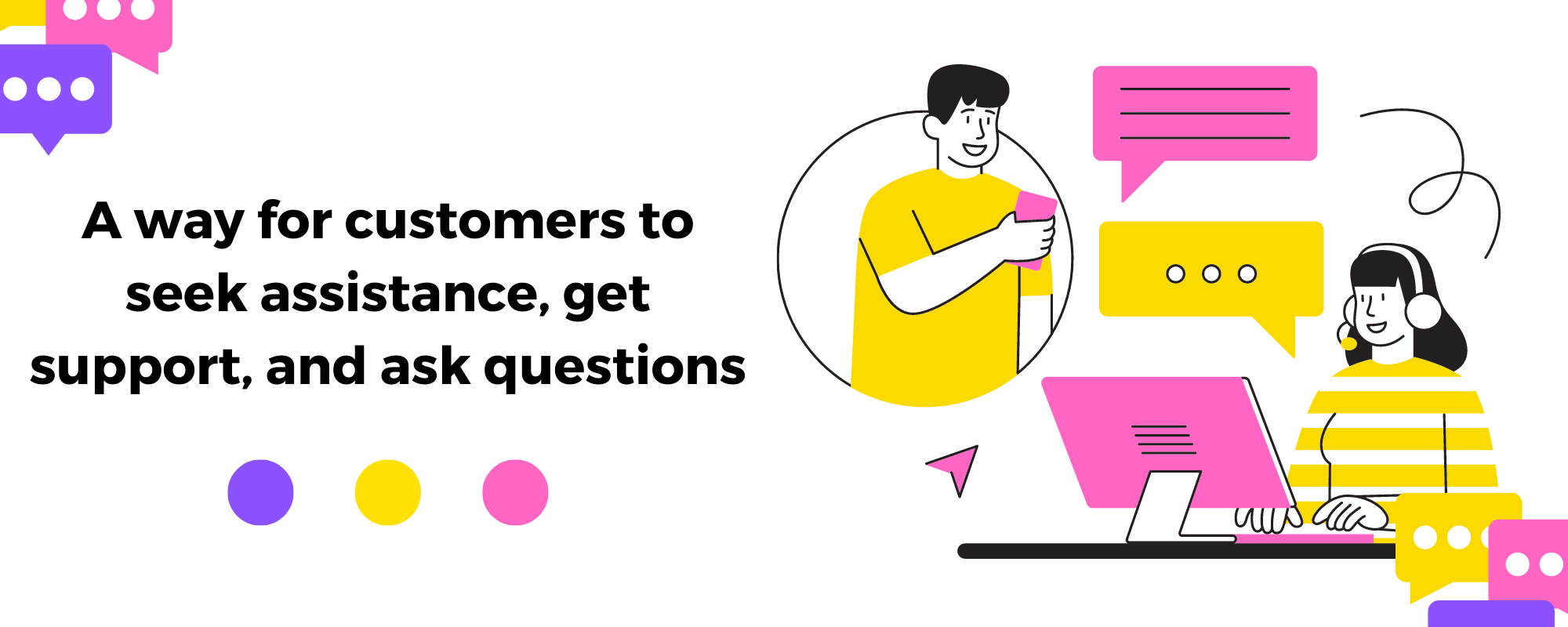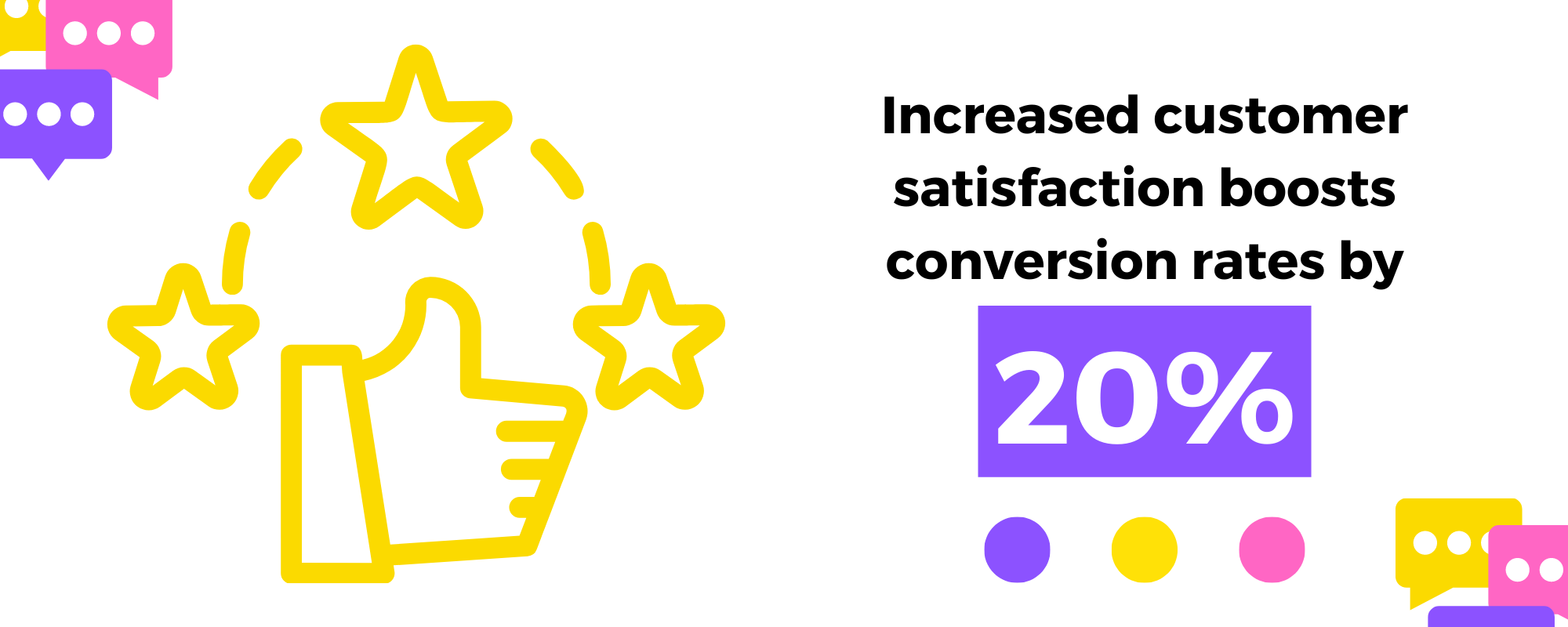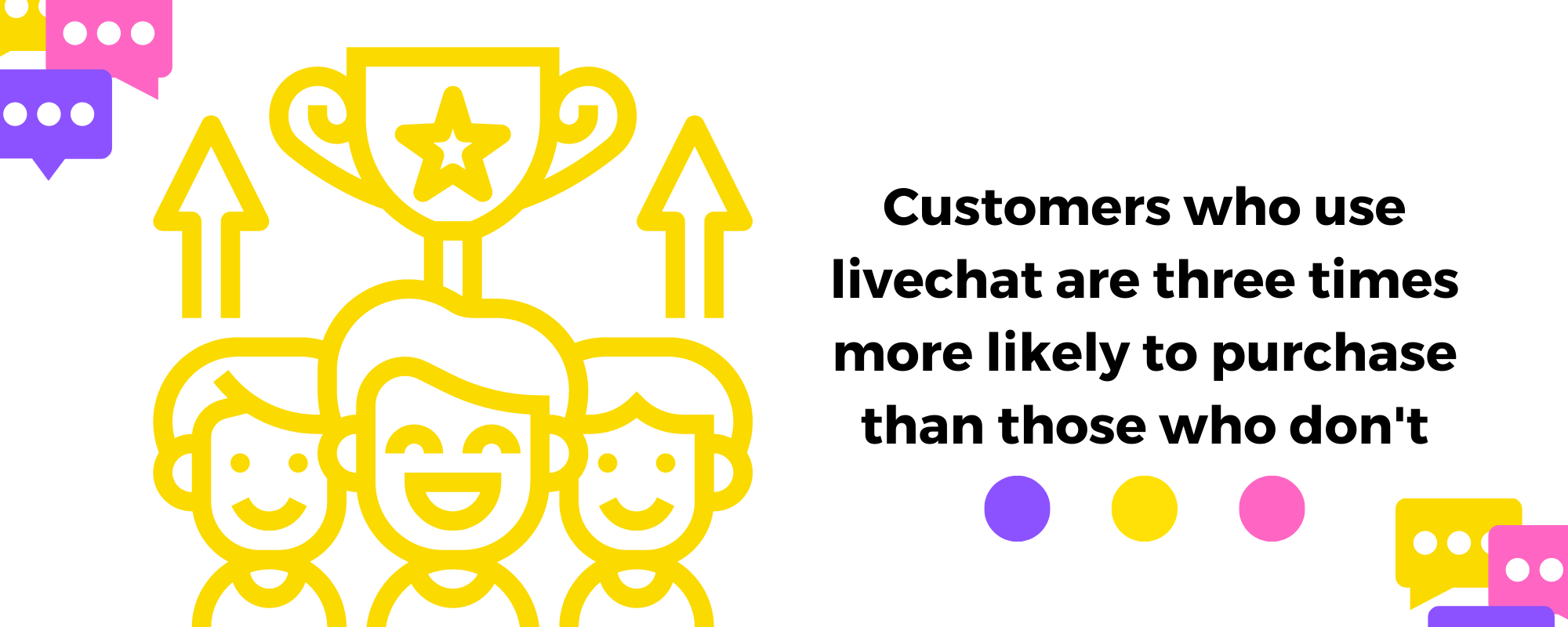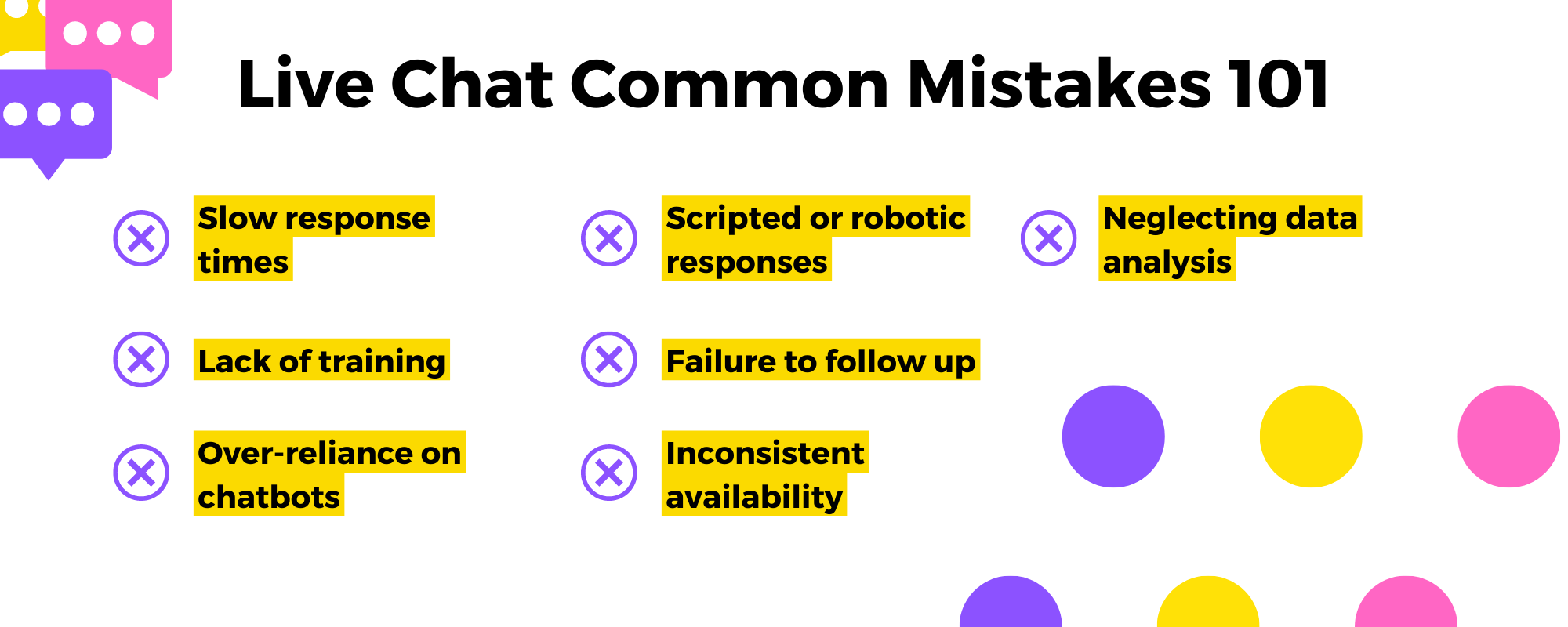Customers have come to expect live chat as a standard feature on business websites, especially in specific industries and niches such as hospitality, services, and SaaS. It’s an integral part of effective customer communication, allowing businesses to engage with their customers in real-time and provide instant assistance.
Live chat goes beyond just being a means of communication; it is also a reflection of your brand and serves as a virtual storefront for your business.
The immediate response and reduced waiting time in live chat contribute to customer satisfaction and loyalty. Additionally, integrating live chat with other support channels, such as email or social media, creates a seamless experience for customers, enabling them to choose their preferred method of communication.
What is live chat?
Live chat is a real-time messaging system that allows website visitors and customers to engage in instant text-based conversations with a business representative or customer support agent.
It is typically integrated into a business’s website or mobile application, providing a convenient and efficient way for customers to seek assistance, ask questions, or get support without the need for phone calls or emails.
Live chat enables businesses to engage with customers in real-time, providing immediate responses, personalized assistance, and resolving issues promptly.
It can be manned by human agents or automated chatbots, depending on the complexity of inquiries and the resources available.
7 Reasons Live Chat Should Be In Your Business Website NOW
The foundation of a successful marketing campaign lies in understanding and catering to the needs of your customers. Just as with any marketing initiative, the live chat feature should be customer-centric, aiming to enhance their experience and meet their communication needs in a tailored and meaningful way.
1. Enhanced Customer Support
The live chat feature on business websites offers enhanced customer support, providing instant and real-time assistance, personalized and tailored responses, and efficient issue resolution.
Studies have shown that live chat can increase customer satisfaction by 73% and boost conversion rates by 20%. It allows businesses to handle multiple customer interactions simultaneously, reducing costs by up to 50% compared to phone support.
With 79% of customers preferring live chat for its convenience, businesses that incorporate this feature can gain a competitive edge, improve customer experience, and drive positive business outcomes.
2. Increased Conversion Rates
Implementing live chat on business websites can significantly impact conversion rates, with statistics showing that it can lead to a 40% increase in conversions.
Live chat also presents opportunities for upselling and cross-selling, with studies indicating that businesses can achieve an average order value increase of 30-50% through these strategies.
Live chat also helps combat shopping cart abandonment, which can account for a potential loss of 69% of sales.
Addressing customer concerns in real-time reduces cart abandonment rates by up to 40%. With these compelling statistics, it is clear that integrating live chat into business websites can significantly improve conversion rates and overall business performance.
3. Improved Customer Experience
Integrating live chat on business websites leads to a significant improvement in the customer experience, backed by compelling statistics. It reduces waiting time, with an average response time of just 2 minutes, minimizing customer frustration.
The seamless integration of live chat with other support channels also enhances the experience, as 51% of customers prefer businesses that offer multichannel support.
These statistics underscore the importance of live chat in delivering a convenient, efficient, and satisfying customer experience.
4. Cost-Efficiency and Scalability
Integrating live chat into business websites offers significant cost-efficiency and scalability benefits. Firstly, it provides cost savings compared to traditional support channels like phone support, with studies showing that live chat interactions cost 17-30% less per contact.
This cost reduction stems from the ability to handle multiple customer interactions simultaneously, as live chat allows customer service representatives to assist multiple customers at once, thereby optimizing resource utilization.
Additionally, live chat integration with chatbots enables automated responses to common queries, further reducing the need for human intervention and increasing efficiency.
These factors combined make live chat a cost-effective and scalable solution for businesses, allowing them to handle higher customer volumes while minimizing operational costs.
5. Valuable Customer Insights
Live chat helps identify pain points and areas for improvement, with businesses reporting that live chat has had a positive impact on their products or services.
Real-time feedback and customer satisfaction measurement further contribute to improved customer experiences, with 85% of customers expressing higher satisfaction levels when live chat is available.
Leveraging these insights help businesses drive customer loyalty, refine their offerings, and achieve long-term success in today’s competitive landscape.
6. Competitive Advantage
68% of customers have a more positive perception of brands that offer live chat support, indicating the influence on brand loyalty and perception. Additionally, customers who engage in live chat are three times more likely to make a purchase and have a higher average order value compared to those who don’t use live chat.
These statistics demonstrate the tangible benefits of live chat in driving customer retention, enhancing brand perception, and increasing revenue, solidifying its role as a valuable tool for gaining a competitive edge in the market.
7. 24/7 Availability
Implementing live chat on your business website provides 24/7 availability, catering to global customers and resolving urgent issues outside regular business hours.
This customer-centric approach is crucial, as 79% of consumers prefer live chat for its instant support and convenience.
Moreover, businesses offering live chat experience a 10% increase in conversion rates and a 48% boost in revenue per chat hour.
Providing support during holidays and weekends, companies can capitalize on the fact that 92% of customers are satisfied when they can access customer service during non-working hours.
This commitment to exceptional customer service builds a reputation that leads to 72% of consumers being more loyal to businesses with live chat capabilities.
7 Live Chat Best Practices for Businesses
Live chat stands out as a unique and challenging medium to master. Balancing the need for real-time responses akin to phone support while dealing with the limitations of typing can be a easy task with these best practices for live chat support:
1. Prompt and proactive engagement
Initiate conversations with website visitors by using proactive chat invitations based on their behavior or specific pages they are browsing.
2. Quick response time
Aim to respond to customer inquiries and messages as quickly as possible. Ideally, strive for a response time of under a minute to provide a seamless and efficient customer experience.
3. Personalization and empathy
Treat each customer as an individual and personalize your responses based on their specific needs. Show empathy and understanding towards their concerns or issues.
4. Clear and concise communication
Use clear and simple language to communicate effectively. Avoid jargon or technical terms that may confuse customers. Break down complex information into easily digestible chunks.
5. Multitasking capabilities
Train chat agents to handle multiple chat conversations simultaneously to optimize productivity and reduce customer wait times. Efficient multitasking skills can improve overall customer satisfaction.
6. Knowledge base integration
Integrate your live chat system with a comprehensive knowledge base to provide instant access to relevant articles, FAQs, and resources. This helps agents quickly find and share accurate information with customers.
7. Post-chat surveys and feedback
Implement post-chat surveys to gather feedback from customers about their experience. Use this feedback to identify areas for improvement and enhance the quality of your live chat support.
7 Common Mistakes to Avoid when using Live Chat
Live chat has emerged as a popular and valuable customer support channel but like any communication method, there are potential pitfalls that can hinder its effectiveness and negatively impact the customer experience.
1. Slow response times
Delayed or slow responses can frustrate customers and negatively impact their experience. Aim to respond promptly and avoid leaving customers waiting for extended periods.
2. Lack of training
Insufficient training for chat agents can result in inconsistent or inaccurate information being provided to customers. Ensure that your agents are properly trained in product knowledge, communication skills, and using the chat platform effectively.
3. Over-reliance on chatbots
While chatbots can be useful for basic inquiries, relying too heavily on them without offering the option for human assistance can lead to customer dissatisfaction. Balance automation with human interaction appropriately.
4. Scripted or robotic responses
Customers appreciate personalized and human-like interactions. Avoid using overly scripted or robotic responses that feel impersonal. Encourage agents to add a personal touch to their conversations.
5. Failure to follow up
Don’t overlook the importance of following up with customers after resolving their issues or inquiries. A lack of follow-up can give the impression of indifference or lack of care for customer satisfaction.
6. Inconsistent availability
If you advertise live chat as a support option, make sure it is consistently available during your stated business hours. Inconsistent availability can lead to customer frustration and disappointment.
7. Neglecting data analysis
Live chat generates valuable data on customer interactions, inquiries, and pain points. Failing to analyze this data and identify trends or areas for improvement can result in missed opportunities for enhancing the customer experience.
Is live chat worth it?
Yes, live chat is definitely worth it for businesses in today’s competitive environment. Customers appreciate the convenience of live chat for obtaining real-time responses, which in turn enhances customer satisfaction, loyalty, and retention rates. And the benefits go beyond customer satisfaction.
Implementing live chat can have a positive impact on your finances. It has the potential to increase conversions and sales, as well as generate higher revenue. Loyal customers tend to be less price-sensitive, contributing to improved profitability.
Considering the low-cost nature of live chat implementation and the potential for a higher return on investment, it becomes an attractive solution for businesses.
If your goal is long-term success, incorporating live chat support on your website is a strategic move. It provides a cost-effective means to improve customer support, increase conversions, and enhance overall business performance.
It is worth seriously considering the implementation of live chat for your website. Talk to us about our Live Chat specialists.












